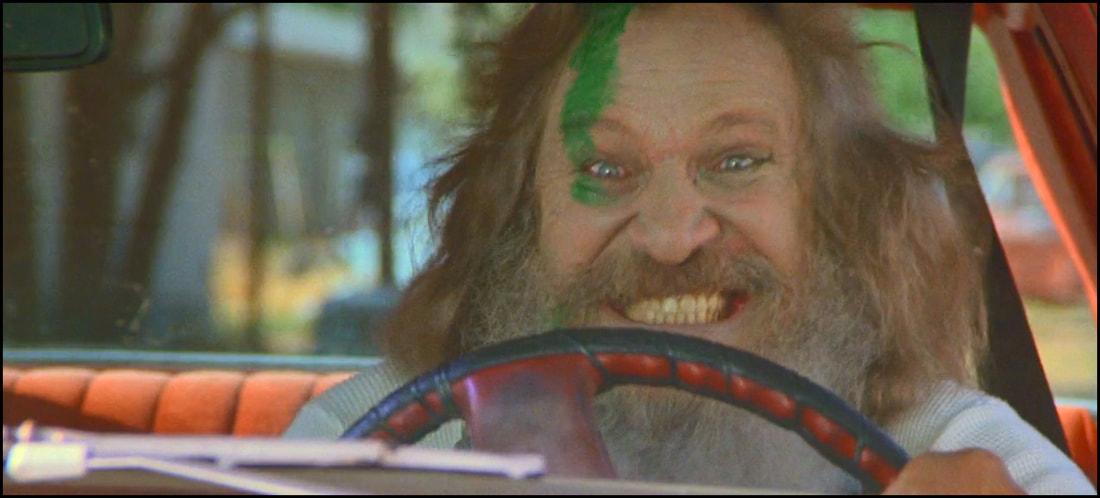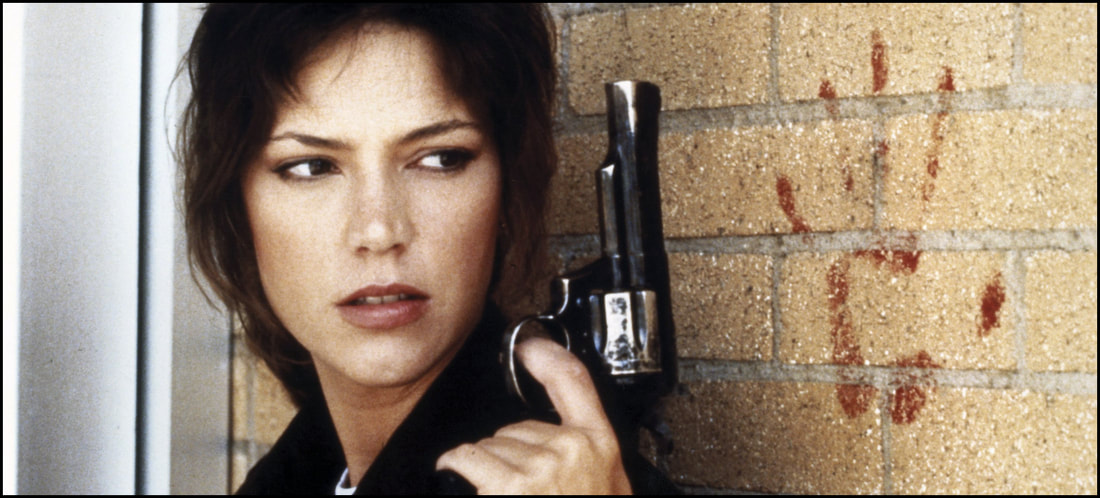Frankly, I have an ever-expanding list. I seriously do. Mostly, I have it because friends and acquaintances know just how hard I can be on productions, so they’ve tried to spare me the experience of sitting through an incredible if not exhaustive number of B-Movies. When I remind them that I tend to enjoy B-Movies far more than I do many mainstream, tent-pole releases, then they might qualify their reasoning further; and it usually boils down to the sentiments that – in their opinion – I just won’t like it. While a good many of them have been proven wrong, I still respect their opinions.
And Nico Mastorakis’ Nightmare At Noon has been on my ‘To Avoid’ list for a very long time.
My memory may be faulty at this point, but I believe I was first exposed to it when a co-worker at the time insisted he found it the worst movie ever made. Given that this fellow and I rarely agreed on a picture (he tended to enjoy a great deal of bizarre projects that left me a bit empty), I challenged him on it, asking for a few more specifics, encouraging him to actually ‘sell me’ on why the film was so bad. In the end, his perspective boiled down to the fact that so much of the resulting action made so little sense, and he conclusively felt it was one I should forever dismiss.
Well …
I’ve gone and done the unthinkable, mostly because that’s what I do from time-to-time, and I finally watched Nightmare At Noon in total. Having done so, I realize that I have seen snippets of it – most likely on various cable airings – so I did have some familiarity with its set-up and some of what my friend suggested was flawed production. The straight skinny is that – entirely as a B-Movie – I didn’t find it nearly as inferior as I expected to … but that may not be a good thing, either.
(NOTE: The following review will contain minor spoilers necessary solely for the discussion of plot and/or characters. If you’re the type of reader who prefers a review entirely spoiler-free, then I’d encourage you to skip down to the last few paragraphs for the final assessment. If, however, you’re accepting of a few modest hints at ‘things to come,’ then read on …)
“Scientists poison the water supply of a small town, turning residents into homicidal maniacs who kill each other and anybody who passes through.”
I’ve often said that one of the pleasures I take from the old-fashioned B-Movie is that – somewhere in all of that mess and gibberish – I often find the grains to a very good idea, and Nightmare At Noon (aka Death Street USA) is no different. Furthermore, writer/director Nico Mastorakis actually constructs his SciFi-lite conspiracy thriller around a fairly solid foundation, but – if I’m staying true to the Golden Rule – he really had miles to go before I decided to release it in the form available for mass consumption.
This Nightmare begins in the dark: some Albino madman sits in the interior of a high-tech, government-issued super-van, and he’s plunking out information on a computer keyboard indicating that his tests are underway. Some backwoods passerby pulls up in a pick-up truck, and – after asking what the lunatic and all his armed henchmen are up to – he’s savagely gunned down, with he and his truck being pushed into some nearby reservoir. Deviously, the villain smiles on, and at this point Mastorakis has firmly established that we’re in for something big masterminded by a rogue with little regard for human life.
Yet, it’s after this terrific set-up that the wheels quickly come off the Nightmare.
Before you know it, we’re introduced to a handful of characters – the true cast we’ll follow much more closely for the rest of the feature. Ken (played by Wings Hauser) and Cheri Griffiths (the stunning Kimberly Beck) travelling the area in an RV, and – for a bit of excitement – they pick up hitchhiker Reilly (Bo Hopkins) on their way into the mountain city of Canyonland. When they arrive, they suddenly find themselves tossed into the middle of madness: something is causing the residents to abandon all reason and lash out violently against their fellow citizens. Once Cheri succumbs to the virus the plot turns personal for Ken and Reilly, and they join Sheriff Hanks (George Kennedy) and his deputized daughter in trying to regain law and order as well as find a solution to this new plague.
In many ways, the idea behind Nightmare – this water-borne experiment enacted on a tiny town in the middle of nowhere – is the kind of thing that has fueled several good thrillers, along with getting screen time in such programs as Millennium, The Stand, and The X-Files. Heck, it’s built even better, more compelling adventures when brought to the silver screen in such films as Invasion Of The Body Snatchers (1956), The Andromeda Strain (1971), or 28 Days Later (2003). When the victims don’t know where it’s coming from and they’re Hell-bent on both uncovering it as well as exposing it, these stories have the opportunity to be so much more than just good entertainment: they end up telling us a bit about ourselves and our society, making us look a bit more closely at how things get done and how we might be hurting ourselves and our environment.
The Albino – dressed like a milkman from the 1950’s – is given no agenda. We’re not told why he’s loosing this plague, and we’re left to only our own individual assumptions. (FYI: that’s never a good narrative decision.) Though he’s given the background of serving the A.P.E. (Agency for the Protection of the Environment), his screen duties do not in any way look like he’s actively trying to do good on behalf of Mother Nature; in fact, it looks like – come the big finish – he was doing this to merely rack up a body count. He even eventually offs all of his henchmen for no reason that’s ever discussed. Such gratuitousness should’ve been explained or relegated to a lesser feature. This is an even greater shame when considering the fact that this character was played by the late Brion James, a man who knew more than his fair share about bringing some of filmdom’s most curious baddies to life.
Also, Mastorakis’ script seems to stumble its way through major and minor plot points and developments, preferring character exposition instead of allowing for events to unfurl organically. Sheriff Hanks and his daughter, in particular, spend an awful lot of screen time filling in the blanks (the pick-up truck found in the lake points to some sabotage; the hospital tested victims’ blood and it’s revealed as acid; the main roads out of town are blocked by some secret technology; how did every magically get healed of the virus; why are there all of these abandoned vehicles parked in the mountains; etc.). Instead of structuring events on film that could’ve underscored such advances in the story, the viewers are told all too often, and this kills any possible momentum the picture could otherwise build on its own merits.
See, there’s a claustrophobia inherent to living in small towns. (I say this as one who grew up in one!) You’re always feeling cut off from a wider world. You’re largely independent from society, and you’re often feeling isolated, especially when help is required. Mastorakis largely ignores this reality, instead mapping out modestly complex run-and-shoot exchanges between Nightmares’ good guys and bad guys. (Somehow, there’s ample ammunition available out here in the sticks!) Eventually, he even stages an elaborate helicopter chase-and-showdown in the mountains that lasts far longer than was absolutely necessary and – gasp! – involves not a single character – good or bad – from the film we just watched. With no investment – with no hero or criminal we know in it – this aerial spectacle feels like a five-minute sidebar all of its own. It ground the picture to a halt like nothing I’ve ever seen.
The sum of all of these weaknesses does keep Nightmare from becoming the small screen’s ‘dream come true.’ At best, the film offers some middling performances from some solid talent … but its core conspiracy remains an idea good enough that it’ll likely continue to live on elsewhere in better productions.
Mildly recommended.
If I’m being total honest with myself, then I’d confess that Nightmare At Noon isn’t as much the bomb I’d been lead to believe it was over the years. Yes, it has some narrative problems here and there; and, yes, the whole premise of the flick’s dastardly villain gets no real exposure. Still, it’s capably made and reasonably well-acted, and that’s in spite of essentially taking audiences on a wild ride with an ending that’s predictably from the onset. But George Kennedy, Bo Hopkins, and Wings Hauser were an affably enough trio in this basement thriller that I can forgive an awful lot of sins.
In the interests of fairness, I’m pleased to disclose that the fine folks at Arrow Films provided me with a complimentary Blu-ray screener of Nightmare At Noon (1988) by request for the expressed purposes of completing this review; and their contribution to me in no way, shape, or form influenced my opinion of it.
-- EZ





 RSS Feed
RSS Feed